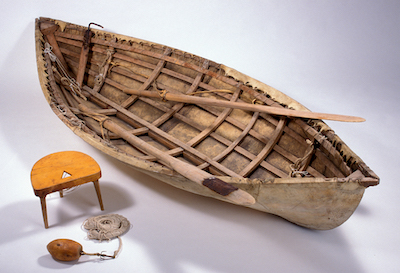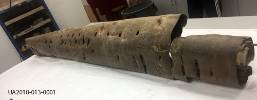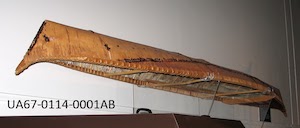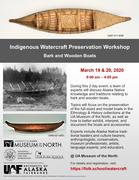Watercraft Workshops



(2021 update: the model of the project has been adjusted to a hybrid plan in order to protect our participants from the ongoing pandemic. We will post updates regarding the webinar that we'll use to share our work and engage with interested members of the public when our cultural experts have completed their visits.)
The ethnology & history department at the University of Alaska Museum of the North
(UAMN) has been granted $57,768 in funding from the NEH HCRR Foundations grant program to host two workshops focusing on our Indigenous watercraft at the museum
in Fairbanks, Alaska. The workshops were intended to bring together a diverse group
of stakeholders including Alaska Native cultural experts, academic researchers, objects
conservators, museum professionals, local craftspeople, and students in order to plan
for a future NEH HCRR implementation grant.
Given the ongoing global pandemic, the museum has been approved to shift into a hybrid
model, where we will invite individual cultural experts to examine the boats at UAMN
in both the exhibit and collections spaces and share their perspectives. These visits
will be filmed and posted online for sharing. We will plan a webinar to share the
results of these visits and to invite participation from the community. We look forward
to continuing the collaboration with The Folk School, a Fairbanks nonprofit that offers year round classes and programs in a wide variety
of hands-on disciplines.
The focus of this NEH HCRR Foundations project is the Indigenous watercraft collection held in the ethnology & history department: sixteen (16) full-sized Alaska Native hand-made boats constructed from local materials; ninety-seven (97) model boats made from the same materials but on a miniaturized scale; and nearly one-hundred (100) accessories that are important to the care and use of those watercraft, including paddles, sleds, and specialized tools for use in them. In order to consider the deep history of these traditions for Alaska Native peoples, well-preserved archaeological boat parts will be singled out for special discussion and comparison with more recent items.
Using the physical objects as the focus of our discussions, project participants will spend one to three days on-site examining and discussing the watercraft and their future physical needs, as well as possible research and community-based projects that could be undertaken using these items. The summary of these discussions will serve as the basis for a future NEH HCRR implementation grant, which will be the primary goal of this project. Special considerations will be taken for the physical care of the objects as well as the kind of cultural information that should be recorded and shared in our online collections database.
We will assemble a team consisting of: at least twelve Alaska Native cultural experts, two academic experts on Alaska Native watercraft, one objects conservator, UAMN-based scientists and museum professionals, artists, Alaska Native language specialists, and local craftspeople. This diverse group will ensure a wide range of goals are met and voices are heard from the very beginning of this project.

From Osgood 1970. Ingalik Material Culture ----
Materials: Spruce wood, spruce root (near the trunk), birch bark, spruce gum glue,
and spruce root line.
Where Used: On rivers, lakes, sloughs, or wherever there is enough unobstructed water over which a canoe can pass.
When used: Whenever lakes and rivers are free of ice (principally June, July, August, and September but also part of neighboring months depending on the year), and when there is not too much wind.
User: A man is the common user of a hunting canoe but a woman may borrow one.
Length of life: A good canoe may last seven seasons, a poor one only one.
Ownership: Man.
---------------------
Our project seeks to expand on this basic information recorded in ethnographic texts.
We hope to learn more about the way canoes were made, stored, and maintained over
its life. We hope participants will share stories and help us better convey the importance
of these nimble crafts and how they were essential to life in Interior Alaska.

"Kayaks are creatures whose native habitat lies beyond the timberline, where the forest ends. To reach the timberline, you either go north, south, or up. There are no kayaks at high altitude, and, for reasons that remain unexplained... there were no kayaks in the southern hemisphere. On the northern hemisphere, the kayak was a circumpolar adaptation, shared among all northern peoples, and differentiated over unknown millennia into an astonishing diversity of forms."
---Harvey Golden, Kayaks of Alaska (2015)
"There are few watercraft with a history as old as that of kayaks. Archaelogical evidence for kayaks shows them to be at least 2,000 years old. Further inferential evidence placed their origins back another 2,000 years and I would not be surprised to find the total age of the kayak to be over 5,000 year.
"Preserved kayak models dating back two millenia were found in a cemetery near East Cape, Siberia. One of the models exhibits characteristics that link it to the umiak, the open skin boat found across the Arctic, the deign of the contemporary Chukchi inland kayaks also preserves umiak construction features. It is very probable that the kayak is a descendant of the umiak.
"Russian linguist G.A. Menovshchikov thinks differently. He studied the etymology of Eskimo - Aleut boat terms. He believes that the proto-Eskimo/proto-Aleut linguistic split took place 4,000 to 5,000 years ago and that the kayak and umiak existed side by side from the beginning.
-David W. Zimmerly, Qaiaq. Kayaks of Siberia and Alaska (1986)
"In the Arctic, where natural building materials are both scarce and limited in variety, the skin boat was a simple and efficient method of gaining access to the water. Prior to the first European contact, the only boats that the Eskimos had were made by covering a light framework of driftwood with sea mammal skins. There were two types: the large open skin boat or umiak, able to hold many people and much cargo, and the smaller canoe-type kayak, decked and usually designed for one person.
"Historically, the Eskimo skin boat was employed from the eastern tip of Asia to the east coast of Greenland."
Stephen R. Braund, The Skin Boats of Saint Lawrence Island, Alaska (1988)

Apply to undertake research in the Indigenous Watercraft Collection at UAMN! Successful
applicants will be paid a stipend up to $500 per day of on-site research (maximum
3 days and $1500 per researcher).
Contact us for additional funding if you require travel support.
Apply Today!
---------------
Webinar -- TBD
Your opinion on the Indigenous Watercraft Project (IWP)
Contact:
Senior Collections Manager: Angela J. Linn, Ph.D.
UAMN Research Associate: Eduard Zdor, Ph.D.

